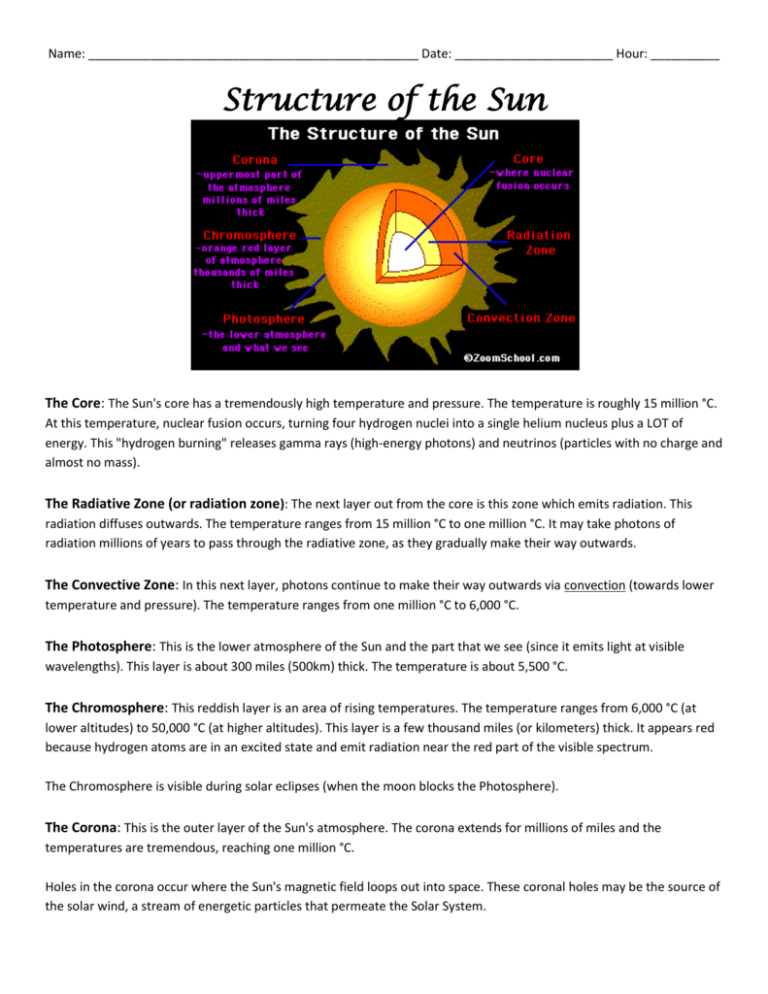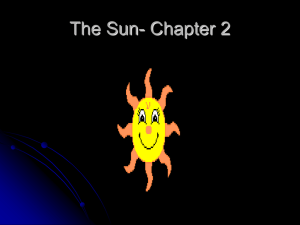3 - Reading and Questions - Structure of the Sun
advertisement

Name: ________________________________________________ Date: _______________________ Hour: __________ Structure of the Sun The Core: The Sun's core has a tremendously high temperature and pressure. The temperature is roughly 15 million °C. At this temperature, nuclear fusion occurs, turning four hydrogen nuclei into a single helium nucleus plus a LOT of energy. This "hydrogen burning" releases gamma rays (high-energy photons) and neutrinos (particles with no charge and almost no mass). The Radiative Zone (or radiation zone): The next layer out from the core is this zone which emits radiation. This radiation diffuses outwards. The temperature ranges from 15 million °C to one million °C. It may take photons of radiation millions of years to pass through the radiative zone, as they gradually make their way outwards. The Convective Zone: In this next layer, photons continue to make their way outwards via convection (towards lower temperature and pressure). The temperature ranges from one million °C to 6,000 °C. The Photosphere: This is the lower atmosphere of the Sun and the part that we see (since it emits light at visible wavelengths). This layer is about 300 miles (500km) thick. The temperature is about 5,500 °C. The Chromosphere: This reddish layer is an area of rising temperatures. The temperature ranges from 6,000 °C (at lower altitudes) to 50,000 °C (at higher altitudes). This layer is a few thousand miles (or kilometers) thick. It appears red because hydrogen atoms are in an excited state and emit radiation near the red part of the visible spectrum. The Chromosphere is visible during solar eclipses (when the moon blocks the Photosphere). The Corona: This is the outer layer of the Sun's atmosphere. The corona extends for millions of miles and the temperatures are tremendous, reaching one million °C. Holes in the corona occur where the Sun's magnetic field loops out into space. These coronal holes may be the source of the solar wind, a stream of energetic particles that permeate the Solar System. Solar Activity SOLAR FLARES A solar flare is a magnetic storm on the Sun which appears to be a very bright spot and a gaseous surface eruption. Solar flares release huge amounts of high-energy particles and gases and are tremendously hot (from 3.6 million to 24 million °F). They are ejected thousands of miles from the surface of the Sun. Solar flares were first observed in 1859 by Lord Richard C. Carrington. He wrote that as he was watching the sun with a telescope, he saw "two patches of intensely bright and white light" near a huge group of sunspots. Just a few seconds later, the flare has disappeared. It has been recently discovered that solar flares can cause sunquakes. Sunquakes are violent seismic events on the Sun. When a sunquake occurs, energy is released in seismic waves on the relatively fluid surface of the Sun. These waves radiate in concentric circles from the epicenter of the sunquake. These seismic waves seem to be compression waves (perhaps like "P" waves generated by earthquakes). Sunquakes would rate about 11.3 on the Richter scale. These huge quakes release about 40,000 times more energy than the 1906 San Francisco earthquake. Sunquakes were first observed by Alexander G. Kosovichev (Stanford University) and Valentina V. Zharkova (Glasgow Univ., UK). SUNSPOTS Sunspots are relatively cool, dark patches on the sun's surface. They come in many shapes and sizes; they often appear in groups. These spots are much bigger than the Earth; they can be over 10 times the diameter of the Earths. Individual sunspots only last for one to two weeks, but the number of sunspots follows an 11 year cycle. The last sunspot cycle peaked in the middle of 2011. Sunspots are visible from Earth. The sunspot cycle was discovered by S. Heinrich Schwabe in 1843 (he started his observations in 1826). SOLAR WIND The solar wind is a continuous stream of ions (electrically charged particles) that are given off by magnetic anomalies on the Sun. The solar wind is emitted where the Sun's magnetic field loops out into space instead of looping back into the Sun. These magnetic anomalies in the Sun's corona are called coronal holes. In X-ray photographs of the Sun, coronal holes are black areas. Coronal holes can last for months or years. It takes the solar wind about 4.5 days to reach Earth; it has a velocity of about 250 miles/sec (400 km/sec). Since the particles are emitted from the Sun as the Sun rotates, the solar wind blows in a pinwheel pattern through the solar system. The solar wind affects the entire Solar System, including buffeting comets' tails away from the Sun, causing auroras on Earth (and some other planets), the disruption of electronic communications on Earth, pushing spacecraft around, etc. SOLAR PROMINENCE A solar prominence (also known as a filament) is an arc of gas that erupts from the surface of the Sun. Prominences can loop hundreds of thousands of miles into space. Prominences are held above the Sun's surface by strong magnetic fields and can last for many months. At some time in their existence, most prominences will erupt, spewing enormous amounts of solar material into space. CORONAL MASS EJECTION Coronal mass ejections (abbreviated CME's) are huge, balloon-shaped plasma bursts that come from the Sun. As these bursts of solar wind rise above the Sun's corona, they move along the Sun's magnetic field lines and increase in temperature up to tens of millions of degrees. These bursts release up to 220 billion pounds (100 billion kg) of plasma. CME's can disrupt Earth's satellites. CME's usually happen independently, but are sometimes associated with solar flares. AURORA Auroras are caused by high energy particles from the solar wind that are trapped in the Earth's magnetic field. As these particles spiral back and forth along the magnetic field lines, they come down into the atmosphere near the north and south magnetic poles where the magnetic field lines disappear into the body of the Earth. The delicate colors are caused by energetic electrons colliding with oxygen and nitrogen molecules in the atmosphere. This excites the molecules, and when they decay from the excited states they emit the light that we see in the aurora. Name: __________________________________________ Date: _________________________ Hour: ______ Structure of the Sun – Label and color each layer in the diagram; then complete the table below. Structure Color Core Blue Radiative Zone Green Convective Zone Purple Photosphere Orange Chromosphere Red Corona Yellow Temperature Function / What Happens Here? Solar Activity – Complete the table giving the cause, effect, and a picture for each type of activity. Activity Sunspot Solar Flare Prominence Coronal Mass Ejection Aurora Cause Effect Picture





